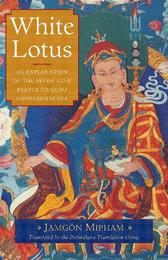
|
White Lotus: An Explanation of the Seven-Line Prayer to Guru Padmasambhava
Paperback / softback
Main Details
| Title |
White Lotus: An Explanation of the Seven-Line Prayer to Guru Padmasambhava
|
| Authors and Contributors |
By (author) Jamgon Mipham
|
|
Translated by Padmakara Translation Group
|
| Physical Properties |
| Format:Paperback / softback | | Pages:144 | | Dimensions(mm): Height 197,Width 127 |
|
| Category/Genre | Buddhism
Tibetan Buddhism |
|---|
| ISBN/Barcode |
9781611802931
|
| Classifications | Dewey:294.3923 |
|---|
| Audience | |
|---|
|
Publishing Details |
| Publisher |
Shambhala Publications Inc
|
| Imprint |
Shambhala Publications Inc
|
| Publication Date |
1 September 2015 |
| Publication Country |
United States
|
Description
The commentary translated in these pages is unusual and rare. But if the commentary is a rarity, its subject matter-the seven-line invocation of Padmasambhava-is one of the best-known prayers in the Tibetan Buddhist world. The overall significance of the Seven-Line Prayer is perhaps best appreciated in relation to a practice called guru-yoga, or "union with the nature of the guru." The purpose of guru-yoga is to purify and deepen the student's relationship with his or her teacher. It is introduced as one of the preliminary practices, and it remains crucial-in fact, its importance increases-as one progresses through the more advanced levels of the tantric path. The cultivation of devotion to the guru and the blending of one's mind with his or her enlightened mind is, in the words of Dilgo Khyentse Rinpoche, "the most vital and necessary of all practices and is in itself the surest and fastest way to reach the goal of enlightenment." Regarding the origin of this commentary, Mipham refers in the colophon to an event that triggered the abrupt appearance in his mind of the hidden meaning of the prayer. It is interesting to note that the language Mipham uses suggests that the commentary itself is not an ordinary composition but perhaps a treasure teaching, specifically a "mind-treasure" or gongter.
Author Biography
Jamgoen Mipham (1846-1912), one of the great luminaries of Tibetan Buddhism in modern times, has had a dominant and vitalizing influence on the Nyingma School and beyond. He was an important member of the Rime, or nonsectarian movement, which did much to strengthen and preserve the entire tradition. A scholar of outstanding brilliance and versatility, his translated works are eagerly anticipated by English-language readers.
Reviews"Enshrining the most sacred prayer to Guru Padmasambhava, the Vajra Seven-Line Prayer, White Lotus elucidates its five layers of meaning as revealed by the eminent scholar Mipham the Great. This commentary now makes this treasure, which has been kept secret among the great masters of Tibet for generations, available as a source of blessings and learning for all."-Tulku Thondup, author of Peaceful Death, Joyful Rebirth "The Seven-Line Prayer is the most majestic of all prayers to Guru Padmasambhava-the buddha for our time. It has been cherished over the centuries as the most powerful way to invoke his blessings. How wonderful that we have this commentary, one of Mipham Rinpoche's most inspiring works, to elucidate these sacred verses and reveal their profound meaning."-Sogyal Rinpoche, author of The Tibetan Book of Living and Dying "Jamgoen Mipham Rinpoche's Pema Karpo is a beautiful and essential text describing the outer, inner, and secret ways that the wisdom in Vajrayana manifests as Padmasambhava. This new translation will be of great benefit to those traveling on the path of tantra."-The Sakyong, Jamgoen Mipham Rinpoche, author of Turning the Mind into an Ally and Ruling Your World
|